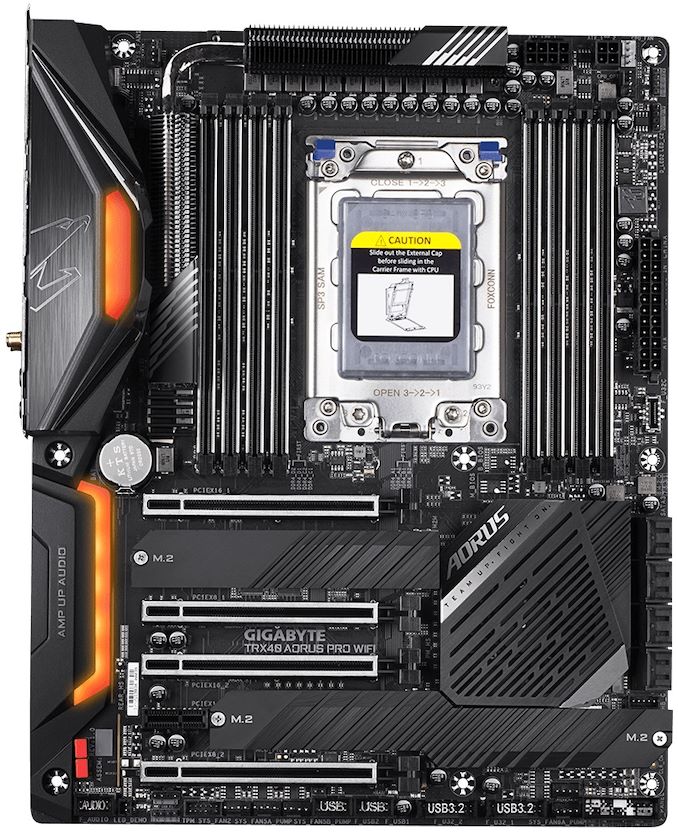The AMD TRX40 Motherboard Overview: 12 New Motherboards Analyzed
by Gavin Bonshor on November 28, 2019 9:00 AM EST- Posted in
- Motherboards
- AMD
- MSI
- Gigabyte
- ASRock
- Asus
- TRX40
- Threadripper 3000
- Castle Peak
GIGABYTE TRX40 Aorus Pro WIFI
Moving our way down the GIGABYTE TRX40 product stack, we have the GIGABYTE TRX40 Aorus Pro WIFI which represents its entry-level model at launch with a good feature set but drops some of the higher-end components to undoubtedly save users money who may not need or require things like 10 GbE. This doesn't mean the feature set isn't good quality as there is an Intel AX200 Wi-Fi 6 wireless interface, three PCIe 4.0 x4 M.2 slots, and support for DDR4-4400 memory across eight slots.
The GIGABYTE TRX40 Aorus Pro WIFI and TRX40 Master share a very similar aesthetic with black metallic heatsinks on an all-black PCB, although the GIGABYTE TRX40 Aorus Pro WIFI is using a standard ATX sized PCB. There are eight memory slots which support up to DDR4-4400 and up to 256 GB in total, with two sets of four slots flanking either side of the sTRX4 CPU socket. All three of GIGABYTE's launch day TRX40 boards are using the high-end Infineon XDPE132G5C 16-phase PWM controller operating at 12+2. The CPU section of the power delivery is a 14-phase design which consists of twelve Infineon TDA21472 70 A power stages for the CPU. Providing power to the CPU is an 8-pin and 6-pin pair of 12 V ATX CPU power inputs.
Cooling the TRX40 chipset is an actively cooled heatsink, while the boards three PCIe 4.0 x4 M.2 slots each include an M.2 heatshield. For users looking to use SATA drives, the GIGABYTE TRX40 Aorus Pro WIFI has eight SATA ports which support RAID 0, 1, and 10 arrays, and are controlled by the TRX40 chipset. Located around the board is eight 4-pin headers which are split into three main sections; one for a CPU fan, one for a water pump, and six for chassis fans. Utilizing as many of the PCIe lanes from the CPU are four full-length PCIe 4.0 slots which operate at x16/x8/x16+x8, with a single PCIe 4.0 x1 slot for good measure.
Unlike the other models in the GIGABYTE TRX40 product stack, the TRX40 Aorus Pro WIFI has a single Ethernet port controlled by an Intel Gigabit controller. For users looking for wireless support, GIGABYTE has included an Intel AX200 Wi-Fi 6 wireless interface which also features BT 5.0 connectivity. Looking at USB support and there is five USB 3.1 G2 Type-A, one USB 3.1 G2 Type-C, and four USB 2.0 ports. Nestled on the left-hand side of the USB 3.1 G2 Type-C port is a small Q-Flash Plus button, while the five 3.5 mm audio jacks and S/PDIF optical output are powered by a pair of Realtek HD audio codecs; an ALC4050H and an ALC1220-VB.
The GIGABYTE TRX40 Aorus Pro WIFI isn't as high-end as its other launch day counterparts, but it still offers a cheaper alternative to users looking to utilize the high core count and power of the Threadripper 3000 processors with an MSRP of $399. Users looking to build a high-core high-thread-count gaming system will be hard pushed to find a better value TRX40 model at launch.












109 Comments
View All Comments
The_Assimilator - Thursday, November 28, 2019 - link
Making a CPU that fits in a socket but doesn't work in it is idiotic. Especially considering the target market, did AMD really need to save a few pennies on getting Lotes to make slight modifications to their TR3 tooling?Spunjji - Friday, November 29, 2019 - link
"Especially considering their target market"System integrators, enthusiasts and experts?
yetanotherhuman - Friday, November 29, 2019 - link
All of them have fans. Bleh. I remember chipset fans. No thanks. X570 is a piece of shit to me for the same reason (apart from that one gigabyte board that costs way too much).jeremyshaw - Friday, November 29, 2019 - link
Also one Asrock board which costs even more!Korguz - Friday, November 29, 2019 - link
all be cause of a chipset fan ?? thats borderline crazy, have you even heard them ? chances are, the other fans in your case would drown it out and you wouldnt even hear ityetanotherhuman - Friday, November 29, 2019 - link
They fail, they're usually a weird size or fitment, and they whine.. case fans are usually much larger and have a far different (and much more pleasant) toneKorguz - Friday, November 29, 2019 - link
i have an Athlon 64 board, with a fan on the chipset, still works just fine, no issues.. nothing.. so those who are wining about these, are unfounded.Larch - Friday, November 29, 2019 - link
Yeah they do fail sometimes (or used to anyway), and it kinda silly that they they nowadays have these weird shapes because of aesthetics making them hard to replace. Not everyone use windowed cases.With that said it shouldn't be a big problem to strap a casefan on in case of failure.
I have the X570 with chipset fan and do wish they would have solved it with a beefier heatsink instead. Seems like a cost issue (in fact I think there is at least one X570 board w/o chipset fan)
eek2121 - Friday, November 29, 2019 - link
It's not how 'beefy' a chipset is, but rather, the size of it. PCIE 4.0 is pushing the chipset, on the current node, to it's limits. A die shrink might fix this, or it might actually make the problem worse.eek2121 - Friday, November 29, 2019 - link
Chances are IF they fail, they are under warranty. If not, you can replace them. However, I've had (non-chipset) fans last for decades. I still have a fan from an old 386 system that works just fine and dandy.